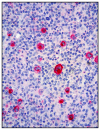EBV-Driven Lymphoproliferative Disorders and Lymphomas of the Gastrointestinal Tract: A Spectrum of Entities with a Common Denominator (Part 1)
- PMID: 34572803
- PMCID: PMC8465149
- DOI: 10.3390/cancers13184578
EBV-Driven Lymphoproliferative Disorders and Lymphomas of the Gastrointestinal Tract: A Spectrum of Entities with a Common Denominator (Part 1)
Abstract
EBV is the most common persistent virus in humans. The interaction of EBV with B lymphocytes, which are considered the virus reservoir, is at the base of the life-long latent infection. Under circumstances of immunosuppression, the balance between virus and host immune system is altered and hence, EBV-associated lymphoid proliferations may originate. These disorders encompass several entities, ranging from self-limited diseases with indolent behavior to aggressive lymphomas. The virus may infect not only B-cells, but even T- and NK-cells. The occurrence of different types of lymphoid disorders depends on both the type of infected cells and the state of host immunity. EBV-driven lymphoproliferative lesions can rarely occur in the gastrointestinal tract and may be missed even by expert pathologists due to both the uncommon site of presentation and the frequent overlapping morphology and immunophenotypic features shared by different entities. The aim of this review is to provide a comprehensive overview of the current knowledge of EBV-associated lymphoproliferative disorders, arising within the gastrointestinal tract. The review is divided in three parts. In this part, the available data on EBV biology, EBV-positive mucocutaneous ulcer, EBV-positive diffuse large B-cell lymphoma, not otherwise specified and classic Hodgkin lymphoma are discussed.
Keywords: EBV-positive; EBV-positive mucocutaneous ulcer; Epstein–Barr virus; classic Hodgkin lymphoma; diffuse large B-cell lymphoma; not otherwise specified.
Conflict of interest statement
The authors declare no conflict of interest.
Figures





References
Publication types
Grants and funding
LinkOut - more resources
Full Text Sources

